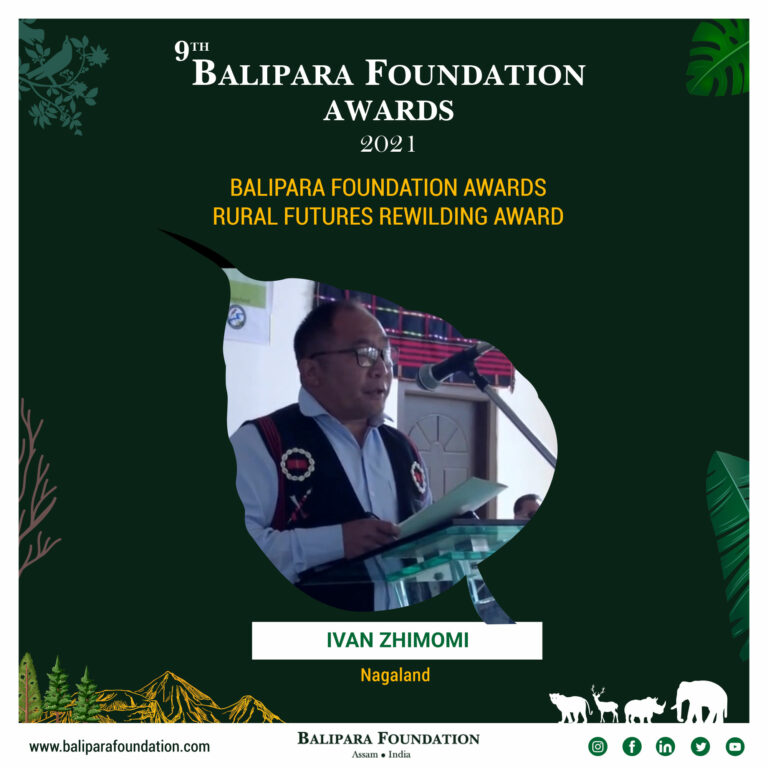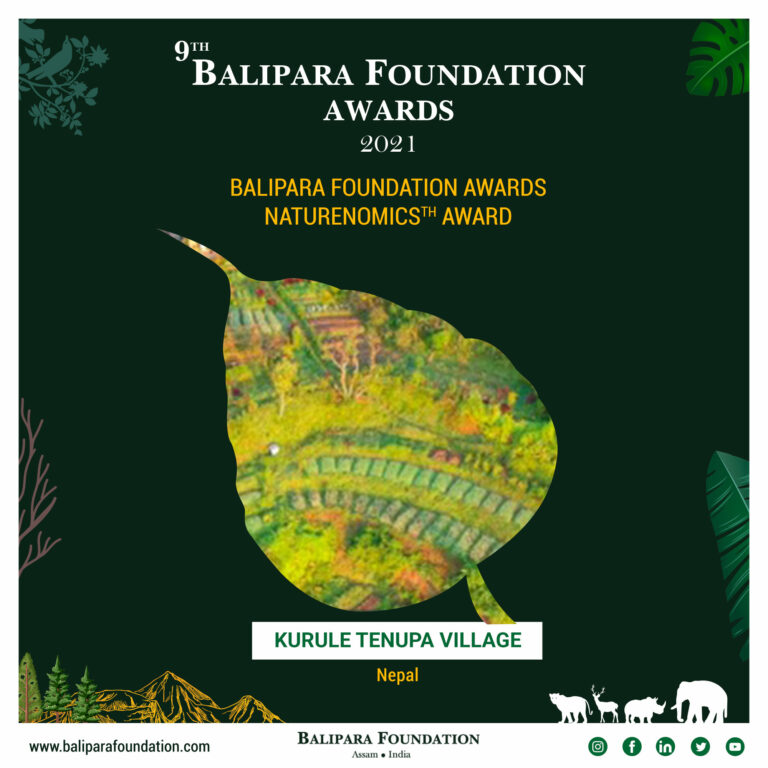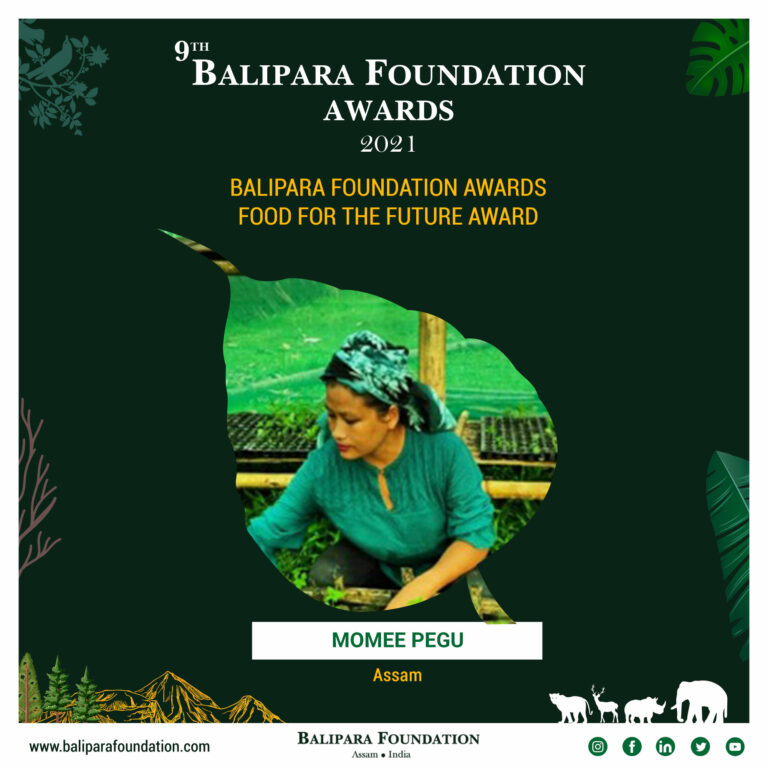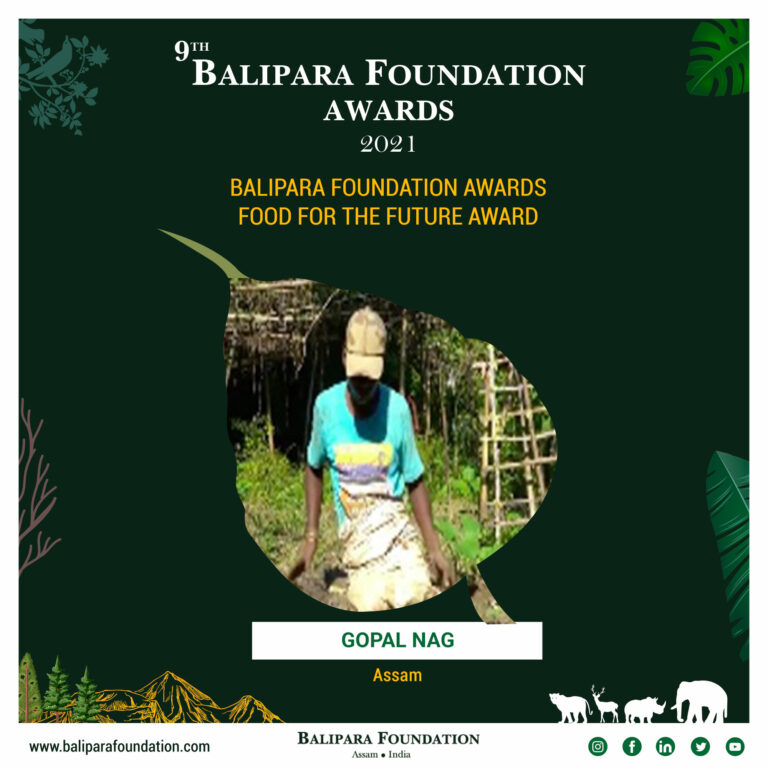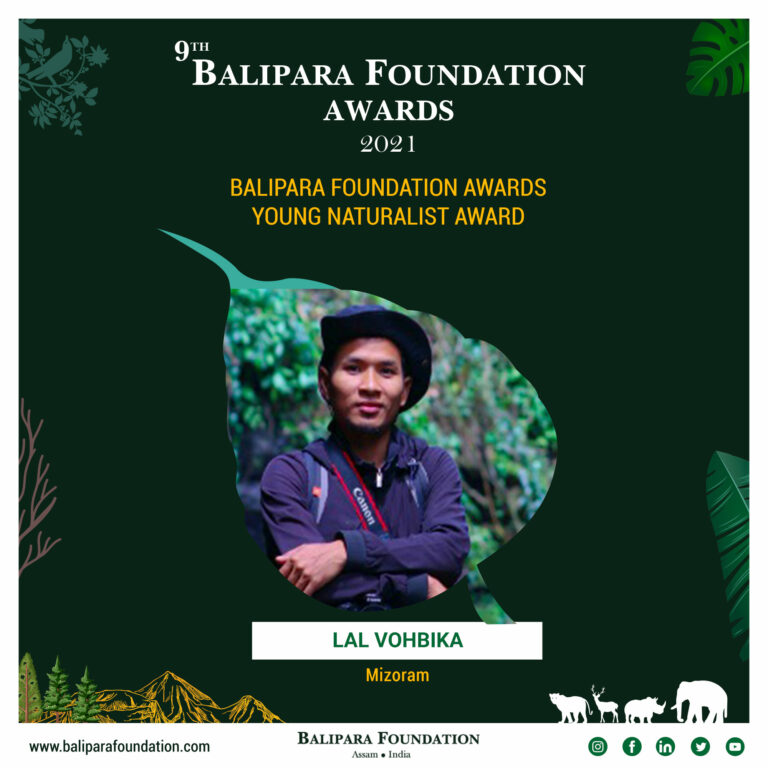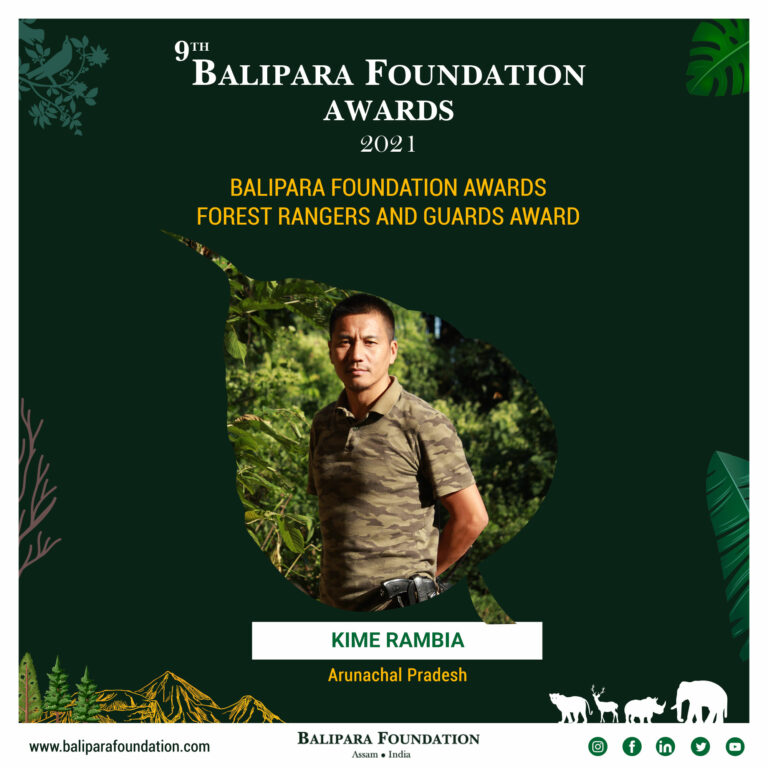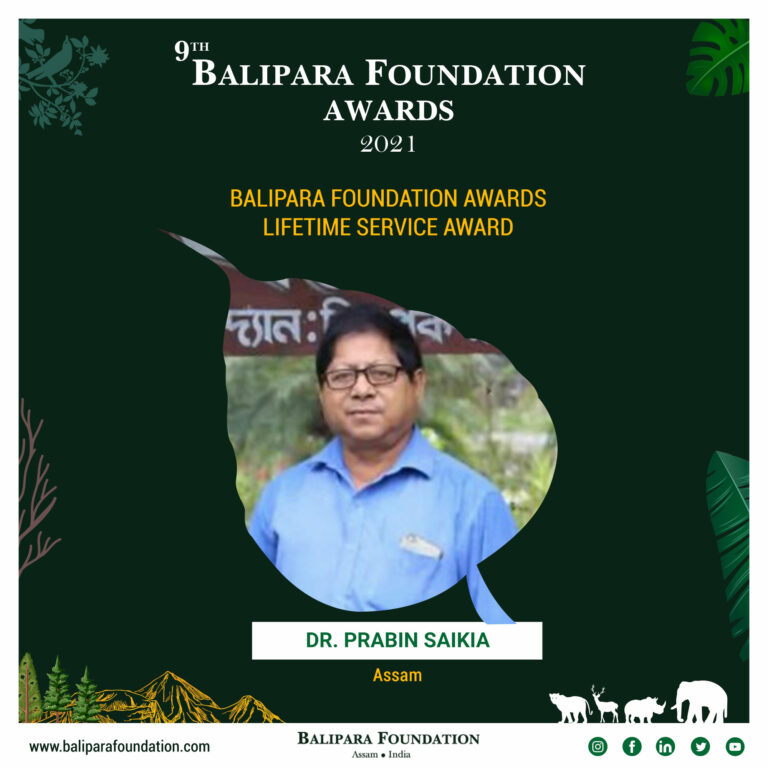“There are some who show us the way forward – these are our Earth Heroes who remain steadfast in their determination to preserve the Eastern Himalayan region.”
Since 2013, Balipara Foundation has highlighted and invested in the efforts of societal entrepreneurs who are working tirelessly to create social, economic, and environmental impacts in protecting the essential natural resources and restoring the diversity of the Eastern Himalayas.
Through the Balipara Foundation Awards, we award, and recognize these extraordinary visionaries of the Eastern Himalayas and their indomitable contribution. Our Awardees continue to live in harmony with nature and adopt sustainable methods for greening the economy. These Grassroots Leaders empower, engage, sensitize their communities towards environmental protection and create opportunities for rural livelihoods. Adopting new technologies and inventions with indigenous knowledge, they are the Custodian Experts of the biodiversity in their region. These entrepreneurs receive a Social Impact Recognition Award which comes with a Citation and a contribution to the organization or individual from Social Impact Recognition Fund of Balipara Foundation. We have come a long way from 2013 and has recognized over 120 earth heroes, who have positively impacted over 2800 livelihoods, restored nearly 2000 hectares of forest lands, and protected over 600 endemic species.
Ivan Zhimomi from Sukhai village, Zunheboto district, is a local champion of mobilising the communities to establish a network of Community Conserved Areas (CCA) and has played the major part in the creation of the ‘The Tizu Valley Biodiversity Conservation and Livelihood Network’ which is critical in reviving the Naga traditional culture, as well as fighting against overhunting, destructive fishing and logging. Ivan has been successful in protecting 939 hectares as community conservation reserve across three neighbouring villages of Sukhai, Kivikhu and Ghukhuyi and by banning hunting and destructive fishing across the remaining landscape of forests and rivers (total area being 3751 hectares). This has helped in documenting and conserving more than 222 species of birds, 200 species of butterflies and counting.
He has actively trained the local youth in biodiversity assessments and sustainable use of natural resources, as well as training and capacity building of local communities for ecotourism, as nature guides, which can result in enhanced livelihood opportunities with the steady flow of tourists that are visiting this area to spot rare bird and butterfly species.
An assessment conducted by TERI to document the resilience status of the three Community Conserve Villages, concluded that due to Ivan’s effort, the importance of stopping hunting to increasing wildlife abundance is now well supported; the role of wildlife in promoting forest regeneration, and the interconnections of healthy rivers and fish abundance is clearly understood; communities have accepted that forests and biodiversity can also realise economic benefits through livelihood alternatives like tourism. Thus their fast eroding awareness of the importance of a healthy landscape to their lives and cultures that was once traditionally embedded in their beliefs and practices is now slowly reviving. Ivan’s achievement of halting hunting and destructive fishing and gathering the local communities together for conservation is path-breaking and very unique for a state like Nagaland.
The village of Kurule Tenupa was once a vibrant community. Unfortunately, it faced the problem of land degradation and infertility of soil after the major Nepal earthquake in the 1990’s, where roughly 150 water essential sources dried up. A mass out-migration followed, and a spell of drought, just about 10 years ago pushed hundreds of families out of Kurule Tenupa village in Nepal’s Dhankuta district.
A few years ago, with an interest to reverse and solve the crisis, the villagers of Kurule Tenupa approached the KTK-BELT to collaborate and formulate a joint project. Since then they’ve set up an organisation called ‘Tamor Permaculture Learning Grounds’ that has been actively stewarding all the local work towards land restoration and transformation. With the technical and little financial support from KTK-BELT, the villages began a feat that no one imagined would be successful, except for themselves! Thirty different species of fruit and nut plants were planted in the Learning Grounds and two ponds have been dug up to cater the water crisis in the village.
The once barren land has now become fertile and is operating as a green organic farm. Hundreds of tourist have visited this permaculture farm in the past years and were amazed to observe the impossible feat,that the village attained through their collaborative and continuous effort of rewilding. The Learning Grounds has eventually transformed into a space where one can study organic farming, a space for kids to learn about outdoor education, and young people find the hope to stay back, work and earn from their own lands. It is acting as a sphere for reverse migration and to build something amazing in the lands of their own village.
Sonam Tashi Gyaltsen is trained as an industrial designer from the National Institute of Design, Ahmedabad. He co-founded Echostream in Gangtok, Sikkim in 2009. Echostream is an evolving community of designers, dreamers, doer’s with professional expertise in industrial and communication design. The Creative Mountain Economy is a model proposed by Echostream to integrate the aspirations of the communities living in a fragile ecosystem.
Sonam also founded La in 2016, as Echostream’s own product/ social enterprise which is focused in developing the creative industry capacity and capabilities in the Indian Himalayan Region starting with Sikkim. La’s products are developed with a systems design approach to solve deep, prevailing problems in the Indian Himalayan Region, with its scope of work ranging from solving problems related to mobility, access to healthcare, reviving traditional knowledge through educational products, urban planning, etc.In 2016, it started building capacities in the bamboo and cane sector through product development workshops with selected master artisans from 23 villages in Sikkim.
Sonam is also the founder of a zero-waste tea brand called T which won the CII-NID Design Excellence award in 2015 in the industrial design category. The effort was to integrate bamboo as a zero waste packaging system for food products in Sikkim starting with Temi Tea from South Sikkim. In 2020, La started an initiative to replace non biodegradable polyester khadas (ceremonial scarf) with cotton screen printed khadas in a mission to eradicate the sacred landscape of polyester khadas. Sonam believes that leadership is not a one person effort, for social enterprise to work, it needs multiple leaderships at all levels of development which Echostream/La has done over the past 12 years in Sikkim.
Layland Marak, is an entrepreneur from Ganolgre village, under the Rongram Community and Rural Development (C&RD) Block of West Garo Hills in Meghalaya. He is engaged in the unique business of processing and sale of Aloe Vera products through a Self Help Group (SHG) named Chizingjang. Layland is considered a pioneer by the people of his village and is attributed to be the driving force behind the Chizingjang SHG, and its aloe vera business.
Sadly, due to his deteriorating eyesight due from a disease he had contracted, Layland had to discontinue his studies. But he never gave up and his perseverance eventually paid off when he secured his first job as a school teacher at the Jengjal Primary School, West Garo Hills in 1995. In 2002, when the North Eastern Region Community Resource Management Project for Upland Areas (NERCOMP) funded by the International Fund for Agricultural Development (IFAD) was in its initial phase, Layland was selected to be one of the members of newly formed Self Help Group (SHG) named ‘Chizingjang’, and also to be a Community Organiser under the Natural Resource Management Group (NaRM-G) formed under the project. Today, Layland is a key member of the Chizingjang SHG responsible for driving the activities of the group which now comprises 78 members.
The Chizingjang SHG did well with other activities under the project and this was noticed by NERCOMP which decided to organise a two-day training on Aloe Vera at Ganolgre in 2006. Six months later, the SHG received 40,000 saplings from an Aloe Vera training institute in Karnataka. But after planting the saplings, the SHG had to put the activity on hold as they did not have technical expertise for processing the Aloe Vera. It was only in 2008 that the business was restarted with the laying of a foundation stone for a new Aloe Vera processing factory by the Deputy Commissioner of West Garo Hills. Today, Layland is a renowned member of the community. From our meeting with him, it is clear that the economic development of Ganolgre has and always will be foremost in his plans, and he has been vocal about the challenges which he has faced and the learning from them.
Momee Pegu is an indigenous Mising woman, from Assam’s river island district, Majuli. She has formed a local Non-Governmental Organisation, named ‘RIGBO’ in 2015 , which means ‘community volunteering for a cause’, in the local tribal language. Pegu has created a sustainable practice among indigenous women of Jengrai Mukh village in Majuli, where they derived a process to convert 11,000 kilograms of the Water Hyacinth plant into organic compost that potentially addresses the sustainability concerns related to agriculture in the locality. With help and support from the village women, she started an initiative that fosters a safe, expressive place for young women in the village. In 2016, she collaborated with 32 other women in the community to empower and engage them in creating a shift in farming.
Pegu has brought the women together through activities such as creating organic pesticides, sustainable and organic farming that gives them the freedom to make their own decisions. The women in the locally formed committee turned the invasive Water Hyacinth plant which grows freely in the streams, ponds, lakes and rivers of the region, into an organic compost that helps deal with some of the issues faced by the agricultural community of Majuli. The income from this compost is distributed equally among the women. Momee says convincing villagers to produce and sell compost was not an easy job. Although many villagers practice agriculture, farmers do not see it as an additional business income. To them, it is more of a source of livelihood. Besides, changing the mindset of the people, the packaging and marketing of the compost is something new to learn for the indigenous farmers, and the NGO is taking great strides through the novel concept introduced by Momee Pegu.
The story of Gopal Nag – from Chandmari Bangali village, in Gohpur division of Assam’s Biswanath district – is one that demonstrates courage and self-confidence. A tragic road mishap in 2014 brought misery to Gopal’s life as he lost both his legs and a major portion of his lower body. He spent nearly 18 months in hospital, and narrowly escaped being paralysed for the rest of his life. Moreover, Gopal was the sole bread earner of his family and had the responsibility of his 12-membered family. The accident shook all their lives deeply.
Despite his disability, Gopal initially cleared a small area of land at his home backyard towards betel nut plantations. Later, he started growing different types of vegetables and also started looking after his small tea plantations. He started cultivating seasonal crops like mustard, black lentil, brinjal, etc. In addition, he also started fishery in another patch of land.
At present, Nag is exploring organic cultivation in his small agricultural land and his cultivated crops and vegetables are capturing a larger market in his locality. He hopes to turn all his aspirations into reality and is making tremendous progress doing so, rising above all odds.
Lal Vohbika is a 28 year old young naturalist, from West Phalleng in Mizoram’s Mammit district. He is known as a hunter-turned-conservationist, and his efforts as a conservator has come a long way to inspire the youth in his district to voluntarily contribute towards wildlife conservation.
Right after leaving school, he bought a locally made gun for Rs 700, and that gun along with his pet dog were his best friends. He was very passionate about hunting and hunted all kinds of animal and bird species. But his life changed in September, 2014, when he got an invitation to work as a wildlife guard at Dampa Tiger Reserve. While working there as a guard, Lal Vohbika realised the immense need for wildlife conservation, not only at Dampa Tiger Reserve, but in the whole of Mizoram.
His new passion led him to connect with Mr. Zakhuma, a famous wildlife photographer from Mizoram, who encouraged him to apply for a training programme at the Green Hub Centre in Assam. Although Lal Vohbika could not fluently speak English or Hindi, his determination for wildlife conservation encouraged him to attend the training against all odds and he underwent a skill training course in videography, photography, filmmaking and wildlife conservation.
Now, Lal Vohbika knows every nook and corner of the Dampa Tiger Reserve. He was also a member of the camera-trapping team, who successfully captured the tiger and the lone pachyderm in the protected area. Lal Vohbika believes through his effort, one day the youth of Mizoram will also realise the need for wildlife and habitat conservation and start shooting birds and animals with a camera, not a gun.
Kime Rambia is a Range Forest Officer based at the Tippi Range, Pakke Tiger Reserve, of East Kameng district in Arunachal Pradesh. This being his first wildlife posting, Kime has brought new life and enthusiasm to his work, and is already widely acknowledged as one of the best rangers Pakke has ever had. He was the first forest official from Arunachal Pradesh to bag the ‘NDTV’s ‘Save Our Tigers Campaign’ Award in 2015, for his outstanding contribution towards conserving the dwindling tiger population at Pakke Tiger Reserve.
Further in 2017, a Rapid Action Project (RAP) initiated by Wildlife Trust of India’s (WTI) Wild Aid Division, under the mentorship of Mr. Rambia extensively focused and helped in mitigating human-elephant conflict in the Tippi-Bhalukpong region of Arunachal Pradesh, ensuring free movement of elephants through the critical Pakke-Doimara at Dadzu-Lumia Elephant Corridor (also known as the Dezzling Elephant Corridor) in the area.
Kime Rambia first brought the issue of the human-elephant conflict in the region to the attention of the WTI. “Earlier there was a lot of conflict between humans and elephants, with damage to property and a potential threat to both human and elephant lives”, says Kime Rambia. “It is heartening that WTI, the forest department and local communities were able to come together to tackle the situation effectively.” Following the RAP, a decision was consequently taken to formulate an effective approach for conservation and sustenance of the elephant corridor, and a plantation drive was conducted by the forest department in the degraded part of the corridor, where daily-wage forest watchers assigned by the forest department to take care of the saplings, under the guidance of Kime Rambia.
Mr. Dorji Duba is currently inducted as a Field Assistant at the Tiger Centre of Bhutan. He had initially joined as a forest guard in the Samdrup Jongkhar Forest Division, in 2000 and has also worked as a forest guard at the Jomotshangkha, the Royal Manas National Park and the Jigme Singye Wangchuk National Park. Being a resilient forest ranger and guard, he never missed out on an opportunity to explore and observe the biodiversity haven that he calls his home.
According to him, it is only possible to protect the forests when you know deeply about its existence. His major feat has been to reach the Black Mountain of Bhutan after trying for 6 long years. Discovering Bhutan’s sheer wilderness in its entirety has been his dream. Over the past 11 years, he has explored many secret nooks and corners of the country and captured thousands of wildlife images. We have a lot to learn from Mr. Duba, with his exemplary determination to conserve forest and biodiversity. He has always put protection of nature and conservation at forefront.
He has also been conferred the ‘Front-line Staff award’ for conservation of nature by WWF-Bhutan and DoFPS. He closely worked with the BBC production ‘The lost land of tigers’, where he did all the camera-trapping for them. He also worked with Emmanuel, who managed to capture the stunning picture of tigers at high altitude in JSWNP in 2016. He is a dedicated forester and he coordinates with all tiger research and conservation work in the field at Bhutan. He is also a field expert in camera trapping and was the first person from Bhutan to get the Snow Leopard picture from JSWNP. He also rediscovered the Primula Chasmophyla, an endemic plant to Bhutan from JSWNP in 2019. Dorji has a strong sense of self-discipline in the field and always makes sure he puts forth the welfare of his team and co-workers first.
Dr. Prabin Saikia, hailing from Madhabpur town of Assam’s Lakhimpur district, is a retired professor of the Department of Assamese, Bihpuria College. Dr. Saikia has meticulously curated a garden of five bighas in his own home— filled with rare, indigenous plants from Assam and the Northeast. This garden has stemmed not just from Saikia’s predilection for botany, but also from love and affection for indigenous plants. “Plants have feelings too,” says Dr. Saikia.
In 2019, Dr. Saikia was honoured with the ‘Plant Genome Saviour Farmers’ award by the Ministry of Agriculture and Farmers’ Welfare, Government of India in New Delhi, for his efforts to protect indigenous flora of Assam. Even as he became the Head of his Department at the college, his interest in botany, mostly self-taught, remained intact within him. In 2004, when he retired, his first move was to buy land from his maternal uncle on credit. “It was a pothaar (field) that no one had used in ages. It took me two years to just fill the land with earth,” says Saikia. Today, the plot of land has transformed into what Saikia calls Banatirtha or a ‘forest of pilgrimage’, filled with more than 500 varieties of plants and trees, as well as birds, bees and butterflies. Among them is the salt-producing flower called the Xotphool, a popular feature in Assamese folklore.
At ‘Banatirtha’, Dr. Saikia is preserving the age-old Assamese traditional knowledge, rituals, beliefs and medicinal usage of indigenous plant species. Through his voluntary contribution towards indigenous plants documentation, he is creating a ‘indigenous plants library’ or a knowledge bank for the future generations. He also conducted several self-initiated research on indigenous tribes like ‘Khamptis’. His self-curated indigenous botanical library is now habitat to many wild species like snakes, butterflies, lizards, birds, mongoose amongst others. Dr. Saikia has left no stone unturned to turn Banatirtha into a heaven of flora.
In the words of Manjit Patir, “With the desire of doing something in memory of my first wife Manika Patir, who left all of a sudden for her heavenly abode in 2002, I decided to donate a tree to the environment. It was in June 2005, that I first put up a sign board on the tree ,where I wrote – ‘Please don’t cut me down. I’m a preserved tree of the Bhikshu Dal. I’ve been donated by Manjit Patir towards nature, in the memory of his wife Late Manika Patir.’
People showed support to Manjit’s idea of offering trees as the abode of departed souls and in due course they started joining him. With the encouraging response of many people and with the hope of making the process more elaborate and formalised, the group ‘Prakritik Bhikshu Dal’ was formed. The human being, which is a creation of nature, has in turn occupied all natural resources, be it land, water, trees or air, to the point of completely destroying its ecological balance without any regard for the future on this planet. Our plant and animal species will not be able to survive without safeguarding its natural resources.
In 2016, the organisation was renamed as ‘Seuji Prithivi Suraksha Abhiyan’ or ‘Save Green World Mission’. It has successfully received donations of trees in various places of Assam. They believe that the amount of damage to the climate that can be caused by lack of large tree cover is beyond belief. A newly planted sapling can never mitigate the harm created by cutting off a big tree. Even the saplings need support from giant trees to grow and a full-grown life ahead. The ‘Save Green World Mission’s first priority is to save the massive trees already there towards the hope for a better future.
Amir Hamza Xihad is the founder of MekATeam, Bangladesh. Amir Hamza Xihad is a youth leader, educator, and an environmental enthusiast working to create both climate and environmental awareness among young people in Bangladesh and around the world.
Through his social organization Mekateam, Amir Hamza Xihad he uses interactive games and training and team building exercises to host workshops on climate change, environmental awareness and the SDGs in a way that makes the learning relatable and easy to understand.


